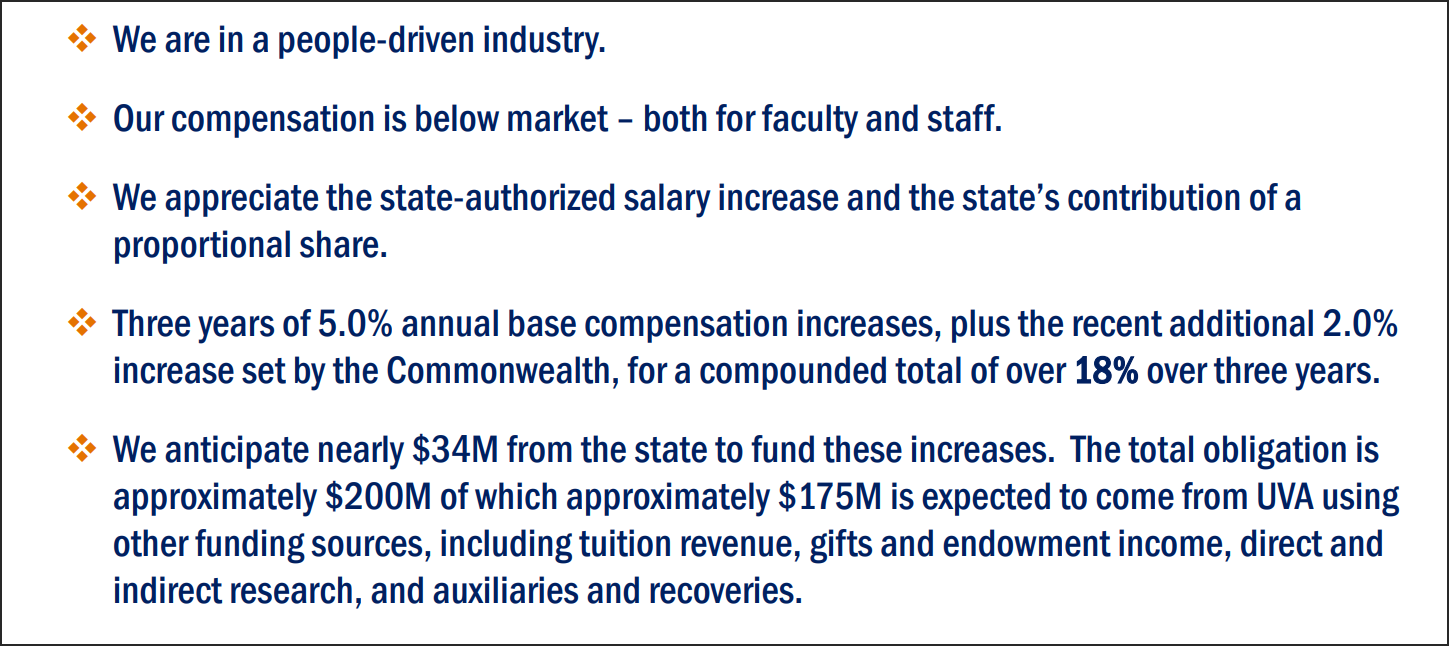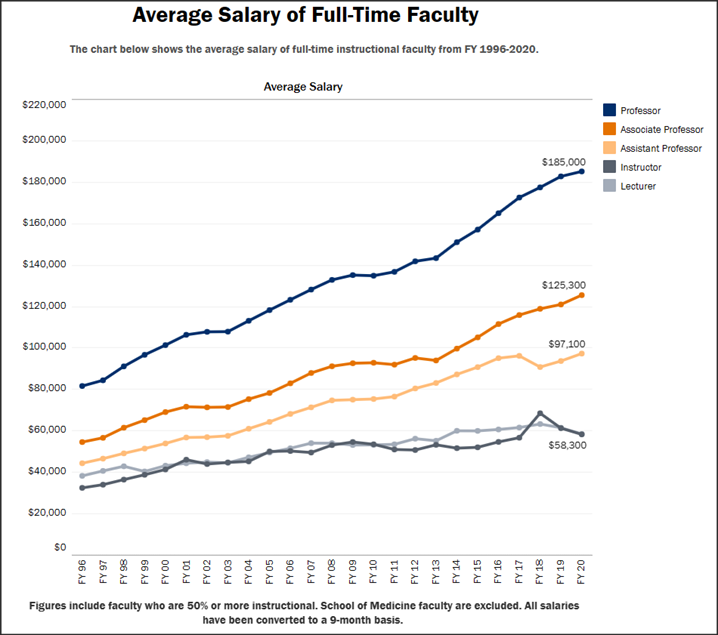 by James A. Bacon
by James A. Bacon
The Ryan administration notched up two big wins in the University of Virginia Board of Visitors meeting Thursday and Friday. It pushed through 3% tuition increases for the next two academic years and it framed the budgetary debate to its advantage. Rather than engaging in a wide-ranging discussion of how UVa might hold down costs, the Board spent most of its time talking about the challenge of hiring and retaining faculty and staff, with the implicit assumption that staying competitive will require higher pay, more money, and higher tuitions.
The administration carefully orchestrated the discussion of tuition & fees from the very beginning — through an initial Finance Committee meeting in October, a public hearing on tuition increases at which only one person testified in November, and then the Board vote Friday. Each step of the way, the administration made lengthy presentations contending that UVa provides a superior value proposition to students, that it has restrained spending, and that inflationary pressures and cutbacks in state funding compel the university to raise tuition. Discussion was restricted to the data presented by the administration. Past efforts by board members to obtain additional information about UVa’s cost structure — in particular, about administrative costs — were ignored.
Bert Ellis, a former president of the Jefferson Council and appointee of Governor Glenn Youngkin, was the only board member to abstain from voting for the tuition increases. The seven other Youngkin appointees on the Board voted for the tuition increases, as did every holdover from the Northam administration.
The Ryan administration presented a case that was sometimes valid but frequently used cherrypicked data or made points that were shorn of context, as the Jefferson Council has documented in previous posts. There are no simple answers to the question of what the “right” level of tuition & fees should be. Optimal tradeoffs between affordability and costs require a vigorous and free-ranging debate at the Board level that simply did not occur.
We will delve into other matters raised during the board meeting in future posts. For now, we will focus on the one issue that did receive significant attention: recruitment and retention of faculty and staff.
“We’re only as good as the talent we attract and retain here,” Chief Operating Officer J.J. Davis told the Board. But UVa is disadvantaged in the competition for talent, she said, by a “resource-constrained environment.”
Here are the relevant bullet points in Davis’ presentation:

Here is how the administration spun the issue in its statement to UVA Today:
Tuition provides revenue that is crucial to instructional and student support as well as faculty and staff salaries in an increasingly competitive hiring market. Following state guidance, UVA has provided 5% raises to its academic division employees in each of the last three fiscal years, and will follow that guidance to provide an additional mid-year 2% increase this month.
During the board meeting, faculty representative Trish Jennings supported Davis’ analysis, declaring, “our salaries are not comparable to our peers’.”
So did Rector Robert D. Hardie, who declared faculty compensation as “something the Board needs to address.” The Board had previously set a goal of getting UVa’s average pay to rank in the top 20 higher-ed institutions but had fallen short. “We’re 27th. The Board really needs to think about that.”
There is more to the story than presented at the Board meeting. This chart, pulled from UVa’s office of Institutional Research & Analytics, shows faculty salary trends.

Between 1996 and 2o22, tenure-track faculty enjoyed salary increases of between 125% to 130% compared to a 64% increase in the Consumer Price Index over the same period. If overall faculty salaries do not match increases for peer institutions, it might be because pay for low-ranking lecturers and instructors were suppressed, falling behind inflation. Has UVa has skimped on salaries for tenure-track faculty? The administration has yet to prove that case.
As superficial and inadequate as it was, the Board conversation about faculty/staff compensation comprised the only substantive public discussion about anything relating to UVa’s cost structure during the two-month process for setting tuition and fees.
All important decisions were made behind the scenes in a process invisible to the public. Last month, for instance, presentations to the Board revealed that the administration was recommending tuition hikes ranging from 3.0% to 4.4%. In the end the Board approved 3.0%. There was no public discussion to arrive at that number. Someone made the decision to settle on 3.0%, which the Board dutifully approved. Who made that decision? I asked Finance Chair Bob Blue how the tuition & fees decisions were made, but he referred me to the UVa public affairs office. I will report back on what I am told.
Paul Manning, a serial entrepreneur who has committed $100 million to a new biotech center at UVa, did raise one question critical for any analysis of faculty compensation: What percentage of the UVa faculty has departed? Has anyone conducted exit interviews to find out if pay was a determining factor?
“We do have that data,” Davis said in response to Manning’s question, but not at her fingertips. She will provide it in the future, she said.
Universities continually raid one another for star faculty, especially those who generate research contracts. It is difficult to prevent a competing institution from swooping in and making a better offer. UVa does the same to others. The pertinent question is how vulnerable is UVa to such poaching. How does churn at UVa compare to peer institutions? If turnover is higher, that might constitute evidence that UVa suffers from a competitive disadvantage.
But that’s not the end of the analysis. Craig Kent, executive vice president for the UVa Health System, added a wrinkle to the discussion. “It’s not just the salary but the package,” he said. When UVa competes against other teaching hospitals for research scientists, the scientist’s personal pay is a factor but it’s part of a deal that includes money for graduate students, laboratory facilities, and other support, he explained.
Yet another factor is the availability of endowment funds to supplement professors’ salaries. A priority in UVa’s current $5 billion fundraising is raising money for faculty endowments. Ryan told the board that, so far, the campaign has raised enough to support 150 endowed faculty chairs. One of the major contributors to that effort, John Nau, sits on the Board. He sat quietly during this discussion.
Other important points were raised — but not pursued — during the hour and a half allotted to the tuition & fees topic, half the time of which was taken up by Davis’s presentation.
Doug Wetmore asked if it were possible for the Board to dig deeper into the budget. The budget-setting process is decentralized, built from the bottom up from the schools and colleges. How does the board evaluate the performance of these university units, he asked? How is productivity measured? What metrics are used?
He received no substantive answer.
Jim Murray, a former rector from the Northam era who has made cost containment a personal mission, said he is optimistic about the future of budgetary analysis. Over the past three years, UVa has implemented Workday, a powerful, cloud-based enterprise software that will allow the administration to conduct types of analysis that it never could before. Also, Murray said, the Youngkin administration hired the Boston Consulting Group (NCG) to lead a statewide data compilation and trend analysis. Complying with that initiative required Davis and her staff to “devote thousands of work hours” to develop the data.
Between Workday and the BCG initiative, Murray said, “the Board has a better opportunity to analyze trends than ever before. … Bert, Bob, and I have been asking questions between meetings,” he said, referring to Bert Ellis and, presumably, Finance Chair Bob Blue. The administration should be in “better shape” to answer those questions going forward, he said.
Murray’s term expires in June.

Leave a Reply
You must be logged in to post a comment.